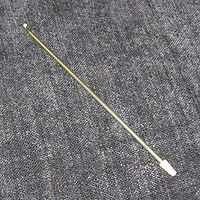
Tunisian crochet
Encyclopedia

Crochet
Crochet is a process of creating fabric from yarn, thread, or other material strands using a crochet hook. The word is derived from the French word "crochet", meaning hook. Hooks can be made of materials such as metals, woods or plastic and are commercially manufactured as well as produced by...
that uses an elongated hook
Crochet hook
A crochet hook is a type of needle with a hook at one end used to draw thread through knotted loops. Only one crochet hook is needed to make crochet stitches. The crochet hook's earliest use appears to have been in the late 18th century or early 19th century.Typical materials for crochet hooks...
, often with a stopper on the handle end, called an Afghan hook. It is sometimes considered to be a mixture of crocheting and knitting
Knitting
Knitting is a method by which thread or yarn may be turned into cloth or other fine crafts. Knitted fabric consists of consecutive rows of loops, called stitches. As each row progresses, a new loop is pulled through an existing loop. The active stitches are held on a needle until another loop can...
. As such, some techniques used in knitting are also applicable in Tunisian crochet. One example is the intarsia
Intarsia (knitting)
Intarsia is a knitting technique used to create patterns with multiple colours. As with the woodworking technique of the same name, fields of different colours and materials appear to be inlaid in one another, but are in fact all separate pieces, fit together like a jigsaw puzzle.Unlike other...
method.
The work is begun with the traditional starting chain, a series of slip stitches. Once the chain is completed, the first row is worked by inserting the hook back into the previous link of the chain, and a loop from the free end of the yarn is grabbed with the hook and pulled back through the link. Unlike traditional crochet, however, this new loop is not then pulled through the initial loop. Both remain on the hook and then the process is repeated, working from right to left, until each link in the chain has been worked. At the end, there will be as many loops on the hook as there are stitches required. This process is called casting on
Casting on (knitting)
In knitting, casting on is a family of techniques for adding new stitches that do not depend on earlier stitches, i.e., stitches having an independent lower edge. In principle, casting on is the opposite of binding off, but the techniques involved are generally unrelated.Casting on can also be...
. This is the first of two parts for creating a row.
The work is never turned. Once the correct number of loops is obtained, the process is reversed with each loop being worked off from the hook by pulling a fresh loop of yarn through each stitch, working from left to right. It is both parts of the process which form a completed row. The tension of the yarn is much looser than in standard crochet or knitting.
There are a variety of stitches than can be created, dependent on how and where the hook is inserted and how the working yarn is held. Tunisian stitches include variations on knit, purl, post stitch, and entrelac, to name a few.
The fabric created by Tunisian crochet is slightly less elastic than normal crochet and substantially thicker, particularly the knit stitch. This makes it most suitable for blankets and winter knits, but unsuitable for finer items like babywear and socks. The fabric also has a tendency to curl, and usually needs to be shaped by wetting or steaming the fabric (known as blocking) upon completion. It is slightly faster to create fabric by Tunisian than normal crochet, and approximately twice the speed of knitting.

